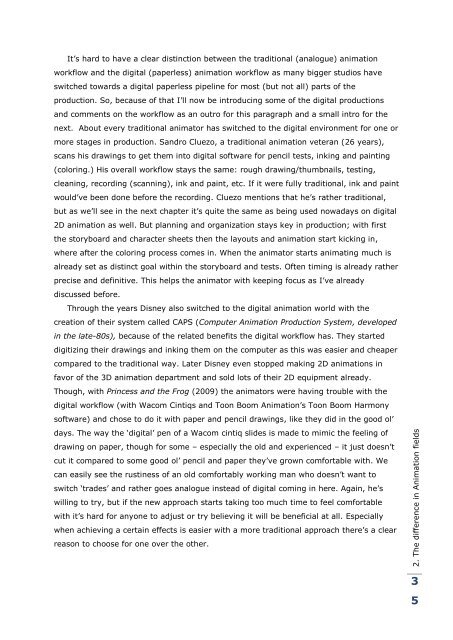Release. Pressure. Animate.
Release. Pressure. Animate.
Release. Pressure. Animate.
Create successful ePaper yourself
Turn your PDF publications into a flip-book with our unique Google optimized e-Paper software.
It‟s hard to have a clear distinction between the traditional (analogue) animation<br />
workflow and the digital (paperless) animation workflow as many bigger studios have<br />
switched towards a digital paperless pipeline for most (but not all) parts of the<br />
production. So, because of that I‟ll now be introducing some of the digital productions<br />
and comments on the workflow as an outro for this paragraph and a small intro for the<br />
next. About every traditional animator has switched to the digital environment for one or<br />
more stages in production. Sandro Cluezo, a traditional animation veteran (26 years),<br />
scans his drawings to get them into digital software for pencil tests, inking and painting<br />
(coloring.) His overall workflow stays the same: rough drawing/thumbnails, testing,<br />
cleaning, recording (scanning), ink and paint, etc. If it were fully traditional, ink and paint<br />
would‟ve been done before the recording. Cluezo mentions that he‟s rather traditional,<br />
but as we‟ll see in the next chapter it‟s quite the same as being used nowadays on digital<br />
2D animation as well. But planning and organization stays key in production; with first<br />
the storyboard and character sheets then the layouts and animation start kicking in,<br />
where after the coloring process comes in. When the animator starts animating much is<br />
already set as distinct goal within the storyboard and tests. Often timing is already rather<br />
precise and definitive. This helps the animator with keeping focus as I‟ve already<br />
discussed before.<br />
Through the years Disney also switched to the digital animation world with the<br />
creation of their system called CAPS (Computer Animation Production System, developed<br />
in the late-80s), because of the related benefits the digital workflow has. They started<br />
digitizing their drawings and inking them on the computer as this was easier and cheaper<br />
compared to the traditional way. Later Disney even stopped making 2D animations in<br />
favor of the 3D animation department and sold lots of their 2D equipment already.<br />
Though, with Princess and the Frog (2009) the animators were having trouble with the<br />
digital workflow (with Wacom Cintiqs and Toon Boom Animation‟s Toon Boom Harmony<br />
software) and chose to do it with paper and pencil drawings, like they did in the good ol‟<br />
days. The way the „digital‟ pen of a Wacom cintiq slides is made to mimic the feeling of<br />
drawing on paper, though for some – especially the old and experienced – it just doesn‟t<br />
cut it compared to some good ol‟ pencil and paper they‟ve grown comfortable with. We<br />
can easily see the rustiness of an old comfortably working man who doesn‟t want to<br />
switch „trades‟ and rather goes analogue instead of digital coming in here. Again, he‟s<br />
willing to try, but if the new approach starts taking too much time to feel comfortable<br />
with it‟s hard for anyone to adjust or try believing it will be beneficial at all. Especially<br />
when achieving a certain effects is easier with a more traditional approach there‟s a clear<br />
reason to choose for one over the other.<br />
2. The difference in Animation fields<br />
3<br />
5


